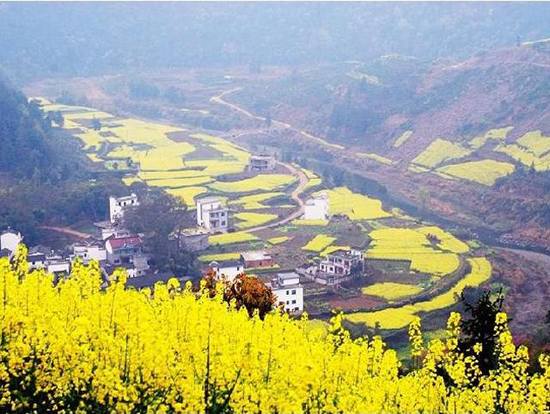Huangshan is heir to the grand cultural traditions and architectural legacies of Huizhou, a historical region that roughly corresponds to the present borders of the municipality.
Huizhou was a cultural powerhouse in the Ming and Qing dynasties (1368-1911), and a rich one at that. Merchants from the area grew wealthy on river through trade and became a political force capable of affecting regional and even national policies.
The monetary wealth of ancient Huizhou also translated into artistic ingenuity. The region pioneered many crafts, chief among which were wood, stone and brick carving, and inkstone production. Today, thanks to tourism and local government initiatives, these crafts are once again thriving, and we toured many an art studio and talked with a number of “cultural inheritors” during our stay in Huangshan.

The physical legacy of the Hui merchants is very visible in the Huangshan of today; their original residences line the corkscrew alleyways of old towns, and archways they constructed in honor of successful family members remain standing after hundreds of years.
Perhaps the most stunning old town in the whole area is that of Shexian, or She County. We’d heard about it before we arrived in town, but hadn’t managed to find space for it in our schedule. We were still interested in exploring the ancient alleyways, however, and so one night we sneaked out from our hotel in search of postprandial adventure.
On approach, Shexian’s old town doesn’t look like anything special. The old city wall, recently reconstructed, is lit up with gaudy fluorescent lights. In through the entrance arch, and things don’t get any better. The main street is thoroughly reconstructed and is lined with identical shops selling throwaway shirts and imitation converse footwear. But head further up the gentle incline of the main street, and the modernity begin to fade. Alleys start darting off to the sides, and the buildings start to look a little less Disney and a lot more historic.
We wandered down an alley and found ourselves on Doushan Street, and archetypal Hui Merchant residential alleyway. Buildings here trace their construction back to the Ming Dynasty. They’re all white, the hallmark color of Huizhou architecture and one that perfectly complements the dazzling yellow of the rapeseed flowers that bloom in early spring. We’d seen similarly monochromatic architecture across Huangshan City; local building codes require it.
Most Doushan residences were enormous; their high outer walls extend at least several stories above the pebbled road along which we sauntered. The night was cloudless and dark, the moon being hidden behind the tall white walls. The only light came from far-off street lamps, and it was tinged an eerie yellow.
Toward the end of the street, we asked for directions from an old-timer who was playing with his grandson. He lived on Doushan, and pointed us back where we’d come from. It seemed we’d seen all we were going to see.
Just as we were turning around, an old lady sprung out of a nearby doorway and struck up a conversation with us. She seemed knowledgeable about the street, and walked with us a little way. We began asking questions – without revealing there were journalists among us – and seeing our interest was piqued, she guided us to another doorway. It turned out to be her house.
We recommend:
